ABSTRACT
This study investigates the impact of school choice on student academic achievement in senior high schools. With an increasing number of families opting for alternative education options such as charter schools, private schools, and magnet programs, it is essential to understand how these choices affect student outcomes. Using a comparative analysis of standardized test scores, graduation rates, and college enrollment data, this research examines the academic performance of students attending schools through various choice mechanisms. Results revealed that the respondents agreed that educational apps significantly contribute to the development of critical thinking and problem-solving skills, as reflected in the grand Weighted mean 1. 12.41 (SD=2.98)
The study controls socioeconomic factors, prior academic performance, and demographic variables to isolate the effect of school choice. Findings suggest that school choice can lead to improved academic achievement, particularly in schools with stronger academic resources and specialized programs. However, the effect varies significantly across different student populations, with students from disadvantaged backgrounds showing more pronounced benefits. The study concludes by discussing policy implications for promoting equitable access to high-quality educational options and enhancing academic outcomes for all students. Results revealed that the respondents agreed that educational apps significantly contribute to the development of critical thinking and problem-solving skills, as reflected in the grand ) Weighted mean 2 12.29(SD=2.70)
CHAPTER I
THE PROBLEM INTRODUCTION
Student’s achievement refers to the extent to which a learner has attained his/her short or long-term educational goals. Individual differences in academic performance are strongly correlated with differences in personality and intelligence.
According to Friedman (1955), school choice in the form of vouchers would exert competitive pressure on school authorities which in turn would lead them to provide higher school quality. On the downside, increased choice can lead to increase sorting by ability. Concurrently, negative peer effects may be experienced by the less able students left behind in the public sector.
In addition, Rashid (2023) said that effects of school choice on student achievement have been a topic of significant debate and research in the field of education. School choice refers to the ability of parents or guardians to select the school that their child attends, which can include public, private, charter, or magnet schools. Proponents argue that school choice can lead to increased competition and innovation, which in turn improves the quality of education and student outcomes. However, critics expressed concerns about potential negative consequences, such as increased segregation and inequality. Research has produced mixed findings, and the impact can vary depending on the specific context and implementation of school choice policies.
Researchers at Nasugbu East Senior High School want to assess how school choice affects the academic achievement of senior high school students. They also aim to gather data on the Impact of school choice on Academic achievement among students in order to create educational programs that will offer valuable insights on this topic.
Background of the Study
The concept of school choice has become a significant area of discussion in educational policy and reform, particularly in its potential to influence student academic performance. School choice allows parents and students to select schools—whether public, private, charter, or alternative—that they believe will best meet their educational needs. This freedom is intended to foster competition among schools, theoretically driving improvements in educational quality and outcomes. Proponents argue that school choice empowers families to select schools that align with their values, learning styles, and academic goals, potentially leading to better student engagement and higher achievement. On the other hand, critics point out that school choice can exacerbate educational inequality, with concerns that the diversion of public funds to private or charter schools could undermine the quality of public education.
A study by abdulkadiroglu et.al (2011), titled "Accountability and Flexibility in Public Schools: Evidence from Boston’s Charters and Pilots," provides insight into the effects of school choice on academic outcomes. Their research focuses on the Boston public school system, examining how charter schools, which operate with greater flexibility than traditional public schools, impact student achievement. The study found that students attending charter schools in Boston performed significantly better on standardized tests than their peers in traditional public schools. This suggests that the autonomy and innovative practices often associated with school choice environments can lead to improve academic performance.
School choice has become a prominent topic in education policy, with growing interest in how different educational settings impact student outcomes. The concept of school choice allows families to select schools, either public or private, based on their preferences, often leading to diverse educational environments. In recent years, researchers have sought to understand how these choices influence student academic achievemet, particularly in senior high school. a critical stage in education, serves as a bridge to higher education or the workforce, making academic achievement at this level crucial for long-term success.
A study by Chakrabarti (2014) explored how school choice affects academic outcomes by examining charter school performance. The research found that students attending charter schools, a popular form of school choice, showed improvements in test scores compared to those in traditional public schools. This provides a basis for further investigation into how various forms of school choice impact the academic success of senior high school students.
STATEMENT OF THE PROBLEM
This study aimed to assess the effect of School choice on Student’s academic achievement of Senior High School Students Specifically, the study sought answer to the following question:
1. How does school choice impact the academic performance of student’s from different socioeconomic backgrounds?
2. How do parent’s reasons for choosing a particular school influence their children’s academic success?
3. What program should be developed regarding the impact of school choice on student’s academic outcomes?
SCOPE AND LIMITATION OF THE STUDY
The study is focused on assessing the effects of school choice on student’s academic achivement of senior high school students, Barangay Lumbangan, Nasugbu, Batangas
The study was limited to Humanities and Social Sciences Students from the aforementioned school.The data were solely gathered from the respondents' answers in the survey questionnaire. The findings were bases for the proposed educational program for students that will contribute to a deeper understanding of the subject.
DEFINITION OF TERMS
Segregation. The action or state of setting someone or something apart from others. It often refers to the enforced separation of different racial groups in a country, community, or establishment (Oxford Dictionaries, n.d.; Merriam-Webster, n.d.). Merriam-Webster. (n.d.). Segregation. In Merriam-Webster.com dictionary. Retrieved from https://www.merriam-webster.com/dictionary/segregation
Foster. To encourage or promote the development of something (usually positive) or to bring up a child that is not one’s own by birth (Oxford Dictionaries, n.d.; Cambridge Dictionary, n.d.). Cambridge Dictionary. (n.d.). Foster. In Cambridge Dictionary. Retrieved from https://dictionary.cambridge.org/dictionary/english/foster
Exacerbate. To make a problem, bad situation, or negative feeling worse (Oxford Dictionaries, n.d.; Merriam-Webster, n.d.). Merriam-Webster. (n.d.). Exacerbate. In Merriam-Webster.com dictionary. Retrieved from https://www.merriam-webster.com/dictionary/exacerbate
Public funds. Money that is generated by the government through taxes and other means, which is used to fund public services and projects (USLegal, n.d.; Law Insider, n.d.). Law Insider. (n.d.). Public funds. In Law Insider. Retrieved from https://www.lawinsider.com/dictionary/public-funds
Prominent. Important, famous, or easily noticeable (Oxford Dictionaries, n.d.; Merriam-Webster, n.d.). Merriam-Webster. (n.d.). Prominent. In Merriam-Webster.com dictionary. Retrieved from https://www.merriam-webster.com/dictionary/prominent
Quality of education refers to the type of education which enables people to develop all of their attributes and skills to achieve their potential as human beings and members of society. https://www.igi-global.com/search/
Particular. Used to single out an individual member of a specified group or class (Merriam-Webster, n.d.).
Socioeconomic.Relating to or concerned with the interaction of social and economic factors (Merriam-Webster, n.d.).
Academic achievements.The measurable performance of a student in their educational pursuits, often reflected in grades, awards, and recognitions (Merriam-Webster, n.d.). School
Choice.The process or policy of allowing parents to select the school their child will attend, often including options outside the public school system (Merriam-Webster, n.d.).
Chapter 2
REVIEW OF RELATED LITERATURES
This chapter presents an intensive review of related literature’s found to be relevant to the present study. This chapter likewise includes the conceptual and theoretical frameworks, and research simulacrum.
Impact of school choice on academic achievements of student from different socioeconomic backgrounds
Some research seems to indicate that a students' homelife and socioeconomic status contribute to their level of academic achievement (Bradley, 2022).
Research indicates that the schools hold the responsibility of student success in a variety of ways, including positive relationships and a supportive school learning environment (Vicki nishioka 2019).
While school culture is identified in various ways throughout the research, the definitions repeatedly align and generally describe the school culture using a combination of the following terms: beliefs, norms, habits, customs, traditions, attitudes, relationships and behaviors within a school (Bayar , 2021) (Atasoy, 2020).
According to (TABITHA SAMUEL 2023) The study investigated the effect of socio-economic background on academic performance and interest among secondary school biology students in Billiri local government area, Gombe state by examine the relationship between Parents’ educational background and students’ academic performance.
According to NLM (2023), impact of socioeconomic is also significant predictor of quality of life, with individuals of higher socioeconomic status reporting better quality of life. However, social capital may play a mediating role in this relationship.
How do parents reason for choosing the particular school to influence children academic success
According to (rowley 2021) Does school racial composition influence where parents choose to send their children to school? This paper contributes to the literature on school racial composition and parental choice by examining the reasons parents give for enrolling their children in predominantly Black magnet school.
According to (fullwood terica2023)The purpose of this qualitative explanatory study was to explore teachers' and parents' perceptions concerning the impact of their relationship on K-12 children's academic achievement. The following research questions guided the study.
Research has documented the complexity of parent decision-making within school choice marketplaces, including the ways in which individual preferences, social networks, and geography influence where parents choose to enroll their children in school (cook walter 2022).
Megha Sushil Sagarwala(2023) Parental engagement in schools is critical to students' success. The problem is parents' lack of engagement in their children's educations may have devastating effects on students' academic and social development. Despite the availability of digital communication platforms and applications, students lack consistency in teacher and parent expectations for their academic performance.
According to William C. James(2024) Parents are increasingly choosing to enroll their students in online schools rather than traditional brick-and-mortar schools. Despite the growth of online schooling, however, there is extremely limited research on such schooling and the role parents play in the educational outcomes of students enrolled in online schools(William C. James 2024).
Theoretical Framework
This study is supported by the Theory of Friedman. Friedman first introduce his theory of school choice in 1995. Friedman's theory is a system, not a cafeteria from which principles can be chosen and implemented at will. School choice principles are interrelated and the proper implementation of one affects the outcome of others. Friedman's model includes a voucher system that would function similarly to the Gl Bill in the United States. Students would be issued vouchers to be redeemed at any accredited educational entity. Friedman's theory, however, is much more than just a voucher system (Friedman 1962, 89; Friedman and Friedman 1980, 161; Friedman 1955); it is a prescription to deregulate and decentralize the education system, thereby enticing additional schools to enter the market. As more schools enter the market, competition increases resulting in more educational options from which parents can choose. In an open market schools are vulnerable to consumer preference, and so parental demand for education plats a large role in the market. Ultimately Friedman theorized that by opening the market and allowing parents to choose, the overall quality of educational entities would increase as parents selected schools that met their quality preference (Friedman and Friedman 1980, 3; Butcher and Burke 2013, 3; Letelier 1976; Burke 2012).
CONCEPTUAL FRAMEWORK
Based on the explained conceptual theory used in this study, the researcher found out that in order to make depth knowledge and careful judgement about the relationship of the variables.It required critical analysis of the variable that can assessing the effect of school choice on students’ academic achievement.
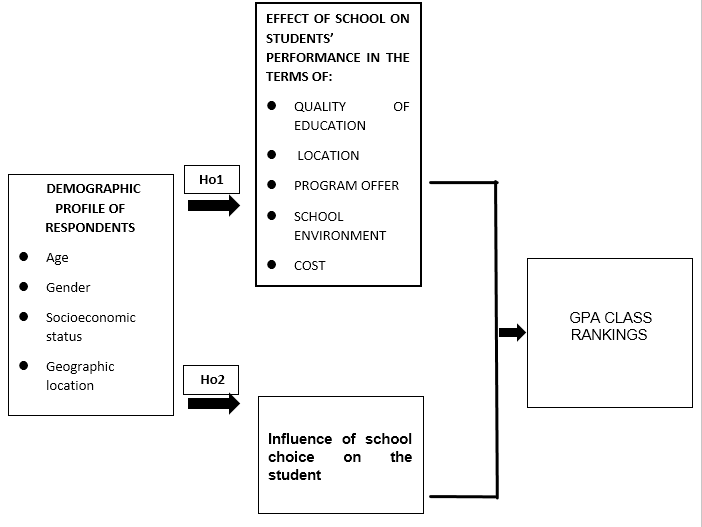
Figure (1) illustrate the research simulacrum of the study it shows the relationship of school choice on student (quality of education, location, program offer, school environment, cost) and the challenges in assessing the school choice that affect the academic performance of students. The finding of the study adheres to formulate gpa class ranking to the effect of school choice to assess the effect of school choice on student academic achievement of senior high school student.
CHAPTER 3
RESEARCH METHODS AND PROCEDURES
This chapter presents the methods of research used It also includes the research design, locale and respondents of the study, research instrument for design, construction and validation of instrument, ethical considerations, data gathering procedures and statistical treatment of data
Research Design
The study used descriptive research design, this type of approach aims to explains phenomena, populations, or situations through patterns of behavior of Grade 11 students of Nasugbu East Senior High School Based on Creswell, the descriptive research design is a study that describes the characteristics of a population or phenomenon being studied. Primarily used to gain an understanding of a group or phenomenon. This involves collecting data through surveys, interviews, or observation. Descriptive research designs answer “Who, What, When, Where, Why, and How.”
Locale of The Study
The study was conducted in Nasugbu East Senior High School located at Brgy. Lumbangan, Nasugbu, Batangas. It was founded in the year 2016. The school was headed by Principal II, with forty-three (46) teachers and eight (9) non-teaching staff. It has a total population of one thousand three hundred four (1,303) enrolled students comprises the grades 11 and 12. There are total of two hundred ninety-five (279) population of Grade 11 and Humanities and Social sciences students this School Year 2024 - 2025. The school offers academic which includes Accountancy, Business and Management (ABM) strand Humanities and Social Science (HUMSS) strand, Science, Technology, Engineering and Mathematics (STEM) strand, and Technical, Vocational.
Respondents of the Study
The sample size for the study was calculated using Slovin’s Formula, which is used to determine an appropriate sample size for a given population with a specified margin of error. Based on a population of 337 HUMSS 11 students, the sample size was determined to be 183 respondents, with a confidence level of 95% and a margin of error of 5%. Simple Random Sampling (SRS) was employed to select the respondents, ensuring that every student in the population had an equal chance of being chosen. This method was used to avoid selection bias and to ensure that the sample accurately represents the population.
Research Instrument
The researcher developed a survey questionnaire to gather data on Assessing the Effect of School Choice on Students Academic Achievement of Senior High School Student. The instrument was structured into two parts: Part I: Part II: A Likert-scale questionnaire measuring the Assessing the Effect of School Choice on Students Academic Achievement of Senior High School Student with a scale of 1-4 (1-Strongly Disagree to 4-Strongly Agree).
Construction and Validation of the Instrument
For the study assessing the effect of school choice on student academic achievement among senior high school students, the research instrument was developed with expert guidance from the thesis adviser. To guarantee clarity and applicability, the original collection of questions was examined and improved several times in response to the adviser's comments. Following adjustments, the instrument underwent additional evaluation by specialists in education to verify that every item accurately assessed the factors associated with school choice and its influence on academic achievement. Through the validation procedure, it was made sure that the questions would produce accurate and insightful data and that they would be in line with the goals of the study. This thorough process helped guarantee the reliability and validity of the research instrument, providing confidence that the study would produce reliable findings and valuable insights into the relationship between school choice and academic achievement.
Ethical Consideration
This study prioritizes ethical considerations, ensuring the voluntary and informed participation of all respondents. Prior to participation, everyone will receive a copy of the informed consent form, which will be thoroughly explained by the researcher. Participants will be explicitly informed that their involvement is entirely voluntary and that they retain the right to decline participation at any time. The study adheres to ethical principles to safeguard the integrity and dignity of all respondents. All collected data will be treated with strict confidentiality and utilized solely for research purposes. Respondent identities will not be disclosed in any publications or presentations stemming from this study. This research aims to conduct a fair and impartial evaluation of the relationship between school choice and senior high school students' academic achievement. The findings of this study should not be interpreted to promote bias or discrimination against any specific school or student group.
Data Gathering Procedure
Before conducting the study on assessing the effect of school choice on student academic achievement among senior high school students, the researcher first obtained permission from the School Principal of Nasugbu East Senior High School and the Public-School District Supervisor. A formal request letter (Appendix A) was sent to the Office of the School Principal to seek approval.
Upon receiving approval, the researcher briefed the target respondents on the objectives of the research, addressing any concerns or questions they had before proceeding with the survey. The researcher then distributed the survey questionnaires, ensuring that the students were given ample time to complete them thoroughly.
To ensure honest responses, the researcher explained the importance of assessing their speculative assertions regarding school choice and academic performance. After the respondents completed the questionnaires, the researcher carefully checked each one to ensure completion before collecting them for analysis.
Statistical Treatment of Data
The following statistical tools were employed in the study to assess the effects of school choice on the academic achievement of senior high school students:
Problem 1: Demographic Profile Frequency and Percentage. These were used to analyze the distribution of respondents based on demographic variables such as age, sex, strand, status, and to express the relative frequency of survey responses regarding academic performance across different socioeconomic groups.
Problem 2: Influence of Parents' Reasons for School Choice on Academic Success Weighted Mean and Standard Deviation. These were applied to determine the average influence of various parental reasons for school choice on students' academic success and to measure the variability of responses. This helped identify which factors were most strongly associated with higher academic achievement.
Problem 3: Program Development for School Choice Impact on Academic Outcomes Weighted Mean and Standard Deviation. These were also used to analyze the respondents’ perceptions of the challenges or advantages they encountered based on their school choice, allowing for the development of potential programs to mitigate negative effects or enhance positive outcomes of school choice on academic performance.
CHAPTER 4
Presentation, Analysis and Interpretation of Data
This part presents the data gathered, analyses and interpretation to answer the problem which this study aims to achieve.
1. Socioeconomic Background on Students Academic Performance
Table 1 presents the socioeconomic background on student academic performance based on the 10 indicators which are presented to the respondents during the conduct of the survey. The highest weighted mean of 12.41 (SD= 2.98) qualitatively describes as, agree. This mean among students school choice has favorable influence on their academic performance However, it convince that school choice provides long term benefits to students and has lowest weighted mean of 7.07 (SD= 1.95) which means most students agree that school offers long term benefits, there’s a wide range of opinions some are very positive but others feltless unconvinced
Overall results show that the respondents mark “Agree” on their academic performance with grand weighted mean 3.14 ( SD= 2.78 )
The result is related to the study conducted by Bourdiev (1980) reveal that socioeconomic factor has strong impact on a student’s academic performance conditions explores the mechanims of student academic performance which are possible means for the identification of the socioenomic.
Table 1 Socio economic Background on Students Academic Performance
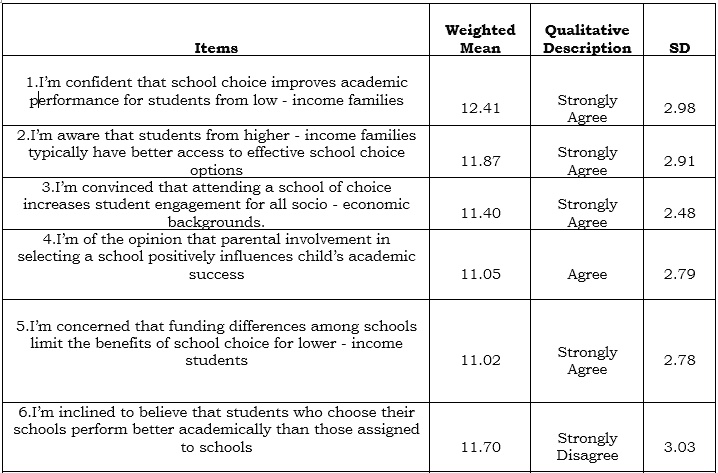
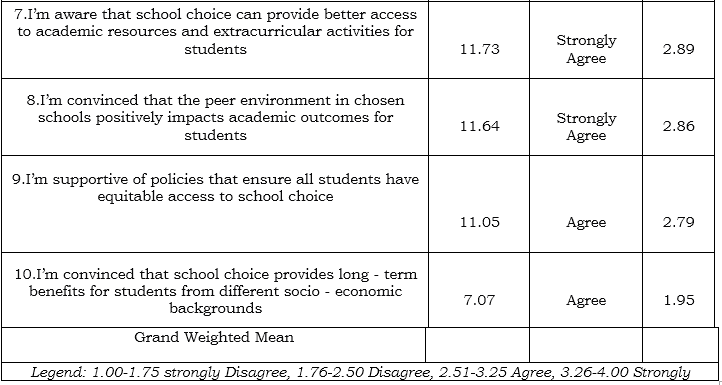
2. Socioeconomic Background on Student Success
Table 2 presented the Socio economic Background success based on the 10 indicators which presented to the respondents during the conduct of the survey The highest weighted mean is the respondents answers the regarding to students influenced by the feedback of their parents received from other parents about the school weighted mean of 12.29 (SD = 2.95) qualitatively describe as Strongly Agree This means that parental perception of the school, Especially influenced by the feedback from other parents play major role in students success However, parents priorities in school choice align with the students personal academic goals and has lowest weighted mean 10.42 (SD = 2.70) which means parents choices for school tend not to strongly reflect their child personal academic ambition this indicator is qualitatively described as strongly agree
Overall results show that the respondents mark" strongly Agree, on socioeconomic background on students success with grand weighted mean of 2.12.29 (C00=296)
The results are related to the study conducted by Banrind who reveals that parental socio-economic background can have possible effects on the academic achievement of children in a school, a student’s educational outcome and academic success.
Table 2 Socio economic Background on Students Success
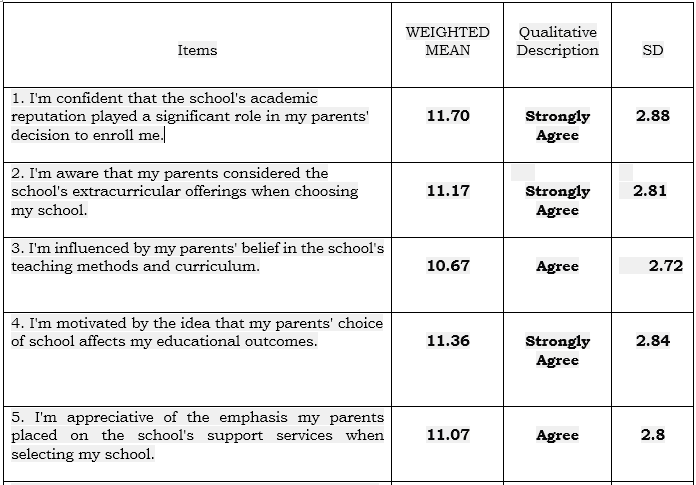
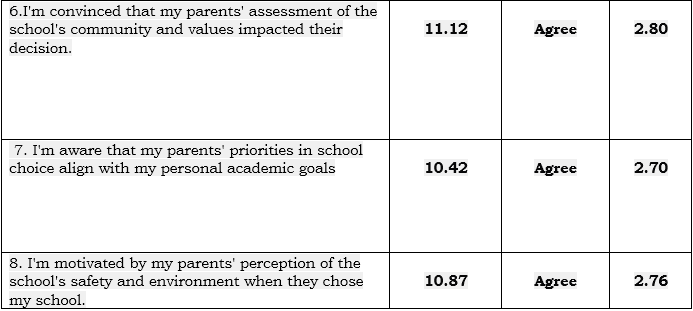

CHAPTER 5
Summary, Conclusion, and Recommendation
This chapter presents the summary of findings, conclusions, and recommendations of the study.
SUMMARY OF FINDINGS
1. Socioeconomic Background on Students Academic Performance presents the socioeconomic background on student academic performance based on the 10 indicators which are presented to the respondents during the conduct of the survey. The highest weighted mean of 12.41 (SD= 2.98).
2. Socioeconomic Background on Student Success presented the Socio-economic Background success based on the 10 indicators which presented to the respondents during the conduct of the survey.
CONCLUSION
1. Impact of school choice on academic performance: Most respondents agreed that school choice improves academic performance across socioeconomic backgrounds, but funding disparities limit its benefits for lower-income students.
2. Influence of parents' school choice on academic success: Parental involvement, especially feedback from other parents, strongly influences school choice and students' success, though alignment with students’ personal goals is less consistent.
3. Program development for enhancing school choice impact: There is strong support for programs ensuring equitable access to quality education, addressing disparities, and improving resources for underprivileged students.
RECOMMENDATION
1. Schools and policymakers should provide clear, accessible information about available school choice options, including eligibility requirements, application processes, and transportation options.
2. Parents should consider both academic quality and the broader educational environment when choosing a school.
3. Longitudinal Study Program - To track academic outcomes over time and measure the effectiveness of school choice.
BIBLIOGRAPHY
Abdulkadiroglu, Atila, Joshua D. Angrist, Susan M. Dynarski, Thomas J. Kane, and Parag A. Pathak, (2011) "Accountability and Flexibility in Public Schools: Evi- dence from Boston's Charters and Pilots," NBER Working Paper No. w1554.https://l.facebook.com/l.php?u=https%3A%2F%2Fwww.uni-goettingen.de%2Fde%2Fdocument%2Fdownload%2Fae116736d3d40569b5ba33ec229f35d5-en.pdf%2FHimmler_School_Choice_NL.pdf%3Ffbclid%3DIwZXh0bgNhZW0CMTAAAR0lyP9Eq32KD2l3Q0NgkDuPLZ3c28NAaqf61F7nLJzkJeY38CmnB2cPFgA_aem_GFDDwZgrwnzT4Umwr4627g&h=AT1jUTRL5LhWhJ6Zxvl4GAULyvjBZvXCYB4eMv3MJwfBV0kID0w_syRcb7gYY_dXEhyytGq8OMtxkgLYdA_PqLLWuV02Gd8NOZArDrouzgD_IifySImPloYepf-cFeJFW8igww
Chakrabarti, R. (2014). "Impact of School Choice on Student Achievement: Evidence from Charter Schools." Education Policy Journal, 22(1), 23-45. https://l.facebook.com/l.php?u=https%3A%2F%2Flimbd.org%2Fcategory%2Fteaching-learning%2F%3Ffbclid%3DIwZXh0bgNhZW0CMTAAAR2XUAa7C9aXFAAQ35S0MWJ19uWiolO0vvzU4xjqdIXqQP9HcL_nkm1X-8A_aem_gfEdrZ1ctP4SMjBYzyytWg&h=AT35CBjmdZyFe-nEdr4QiHCbSpmW2GawPl30yWmNs5wuylVY_YThQ8ELLqRDHRXXR92ySEdUulLIhA2ctLznVOLc3dbZcwQ6d9v061CSqV0OJ_xpycd2sfxc_rdM_-hPBuYEcwea8RRvu8w
Friedman, M. (1955). "The role of government in public education." In Economics and the Public Interest, ed. RA Solo. University of Rutgers Press. New Brunswick.https://l.facebook.com/l.php?u=https%3A%2F%2Fwww.uni-goettingen.de%2Fde%2Fdocument%2Fdownload%2Fae116736d3d40569b5ba33ec229f35d5-en.pdf%2FHimmler_School_Choice_NL.pdf%3Ffbclid%3DIwZXh0bgNhZW0CMTAAAR1bWyC1m7MkcXu_ZElQYnpFnMOHrIAT_0u831JHlPL3qeUVLp7eu7bpU68_aem_JlcKgDTf7YvrY2NXWa-g3w&h=AT1Kuqm4FZC0L0aOWm5gcD84jg8W99ojHN_gKKlEQ5S6cNte4GP0-uDBJ_REqm6M504IVb1cJi7itHYoG2cgNduk4gQIK5LpEa5xuYxdrOdoiijtnAPuSvM4qLZMGz_k-_0x_w
Md. Harun Ar Rashid (2023) study The Effects of School Choice on Student Achievement Former Student at Rajshahi University https://l.facebook.com/l.php?u=https%3A%2F%2Fwww.uni-goettingen.de%2Fde%2Fdocument%2Fdownload%2Fae116736d3d40569b5ba33ec229f35d5-en.pdf%2FHimmler_School_Choice_NL.pdf%3Ffbclid%3DIwZXh0bgNhZW0CMTAAAR2kpfdNQ9iLe5fgaDRSQ8qv9nZPCFitoQuft1jQwnbfpJ1DYckuZePtPoM_aem_5pA2Kteyw4bMISuRMIlY-A&h=AT1Kuqm4FZC0L0aOWm5gcD84jg8W99ojHN_gKKlEQ5S6cNte4GP0-uDBJ_REqm6M504IVb1cJi7itHYoG2cgNduk4gQIK5LpEa5xuYxdrOdoiijtnAPuSvM4qLZMGz_k-_0x_w
https://l.facebook.com/l.php?u=https%3A%2F%2Fwww.researchgate.net%2Fpublication%2F371350334_The_Impact_of_Socio-economic_Status_on_Academic_Achievement%3Ffbclid%3DIwZXh0bgNhZW0CMTAAAR2As6orV3GKj8hmib1N94tUoODxkKqvNTlIfkTBNVAuhNZVhoSU4kEYH38_aem_RhtFx8B5a4oRhR-UYRElrQ&h=AT2GjzsC69EhM7_z79UMJp3Q-QmHgjqKUauRXR3zUaFSGoSw9V0d9e9yH1h87xjRCDzmEAx-lniIe4a7EnusJixR-gfSalfeKq4u4QNdX82FpXjmE0zH9ln1nAVTnArnwm5S3g
https://www.ncbi.nlm.nih.gov/pmc/articles/PMC10001315/
https://l.facebook.com/l.php?u=https%3A%2F%2Feric.ed.gov%2F%3Fredir%3Dhttp%253A%252F%252Forcid.org%252F0000-0003-1025-8219%26fbclid%3DIwZXh0bgNhZW0CMTAAAR20_o2digVpKh89Wb-GRBjlQWzB147ryLS9hrhyyYpkKzbCssEqzKDWsls_aem_KZgBKpdP6Ky6-Yc-Amvp1A&h=AT2GjzsC69EhM7_z79UMJp3Q-QmHgjqKUauRXR3zUaFSGoSw9V0d9e9yH1h87xjRCDzmEAx-lniIe4a7EnusJixR-gfSalfeKq4u4QNdX82FpXjmE0zH9ln1nAVTnArnwm5S3g
https://l.facebook.com/l.php?u=https%3A%2F%2Fwww.researchgate.net%2Fpublication%2F371350334_The_Impact_of_Socio-economic_Status_on_Academic_Achievement%3Ffbclid%3DIwZXh0bgNhZW0CMTAAAR2As6orV3GKj8hmib1N94tUoODxkKqvNTlIfkTBNVAuhNZVhoSU4kEYH38_aem_RhtFx8B5a4oRhR-UYRElrQ&h=AT2GjzsC69EhM7_z79UMJp3Q-QmHgjqKUauRXR3zUaFSGoSw9V0d9e9yH1h87xjRCDzmEAx-lniIe4a7EnusJixR-gfSalfeKq4u4QNdX82FpXjmE0zH9ln1nAVTnArnwm5S3g
https://www.ncbi.nlm.nih.gov/pmc/articles/PMC10001315/
https://l.facebook.com/l.php?u=https%3A%2F%2Feric.ed.gov%2F%3Fredir%3Dhttp%253A%252F%252Forcid.org%252F0000-0003-1025-8219%26fbclid%3DIwZXh0bgNhZW0CMTAAAR20_o2digVpKh89Wb-GRBjlQWzB147ryLS9hrhyyYpkKzbCssEqzKDWsls_aem_KZgBKpdP6Ky6-Yc-Amvp1A&h=AT2GjzsC69EhM7_z79UMJp3Q-QmHgjqKUauRXR3zUaFSGoSw9V0d9e9yH1h87xjRCDzmEAx-lniIe4a7EnusJixR-gfSalfeKq4u4QNdX82FpXjmE0zH9ln1nAVTnArnwm5S3g
Abdulkadiroglu, Atila, Joshua D. Angrist, Susan M. Dynarski, Thomas J. Kane, and Parag A. Pathak, (2011) "Accountability and Flexibility in Public Schools: Evi- dence from Boston's Charters and Pilots," NBER Working Paper No. w1554.https://l.facebook.com/l.php?u=https%3A%2F%2Fwww.uni-goettingen.de%2Fde%2Fdocument%2Fdownload%2Fae116736d3d40569b5ba33ec229f35d5-en.pdf%2FHimmler_School_Choice_NL.pdf%3Ffbclid%3DIwZXh0bgNhZW0CMTAAAR0lyP9Eq32KD2l3Q0NgkDuPLZ3c28NAaqf61F7nLJzkJeY38CmnB2cPFgA_aem_GFDDwZgrwnzT4Umwr4627g&h=AT1jUTRL5LhWhJ6Zxvl4GAULyvjBZvXCYB4eMv3MJwfBV0kID0w_syRcb7gYY_dXEhyytGq8OMtxkgLYdA_PqLLWuV02Gd8NOZArDrouzgD_IifySImPloYepf-cFeJFW8igww
Md. Harun Ar Rashid (2023) study The Effects of School Choice on Student Achievement Former Student at Rajshahi University https://l.facebook.com/l.php?u=https%3A%2F%2Fwww.uni-goettingen.de%2Fde%2Fdocument%2Fdownload%2Fae116736d3d40569b5ba33ec229f35d5-en.pdf%2FHimmler_School_Choice_NL.pdf%3Ffbclid%3DIwZXh0bgNhZW0CMTAAAR2kpfdNQ9iLe5fgaDRSQ8qv9nZPCFitoQuft1jQwnbfpJ1DYckuZePtPoM_aem_5pA2Kteyw4bMISuRMIlY-A&h=AT1Kuqm4FZC0L0aOWm5gcD84jg8W99ojHN_gKKlEQ5S6cNte4GP0-uDBJ_REqm6M504IVb1cJi7itHYoG2cgNduk4gQIK5LpEa5xuYxdrOdoiijtnAPuSvM4qLZMGz_k-_0x_w
Friedman, M. (1955). "The role of government in public education." In Economics and the Public Interest, ed. RA Solo. University of Rutgers Press. New Brunswick.https://l.facebook.com/l.php?u=https%3A%2F%2Fwww.uni-goettingen.de%2Fde%2Fdocument%2Fdownload%2Fae116736d3d40569b5ba33ec229f35d5-en.pdf%2FHimmler_School_Choice_NL.pdf%3Ffbclid%3DIwZXh0bgNhZW0CMTAAAR1bWyC1m7MkcXu_ZElQYnpFnMOHrIAT_0u831JHlPL3qeUVLp7eu7bpU68_aem_JlcKgDTf7YvrY2NXWa-g3w&h=AT1Kuqm4FZC0L0aOWm5gcD84jg8W99ojHN_gKKlEQ5S6cNte4GP0-uDBJ_REqm6M504IVb1cJi7itHYoG2cgNduk4gQIK5LpEa5xuYxdrOdoiijtnAPuSvM4qLZMGz_k-_0x_w
Chakrabarti, R. (2014). "Impact of School Choice on Student Achievement: Evidence from Charter Schools." Education Policy Journal, 22(1), 23-45. https://l.facebook.com/l.php?u=https%3A%2F%2Flimbd.org%2Fcategory%2Fteaching-learning%2F%3Ffbclid%3DIwZXh0bgNhZW0CMTAAAR2XUAa7C9aXFAAQ35S0MWJ19uWiolO0vvzU4xjqdIXqQP9HcL_nkm1X-8A_aem_gfEdrZ1ctP4SMjBYzyytWg&h=AT35CBjmdZyFe-nEdr4QiHCbSpmW2GawPl30yWmNs5wuylVY_YThQ8ELLqRDHRXXR92ySEdUulLIhA2ctLznVOLc3dbZcwQ6d9v061CSqV0OJ_xpycd2sfxc_rdM_-hPBuYEcwea8RRvu8w